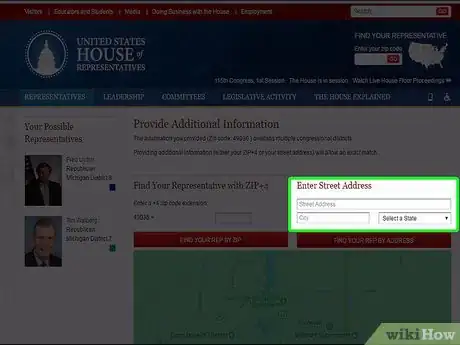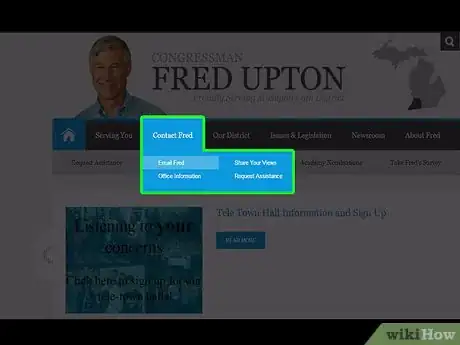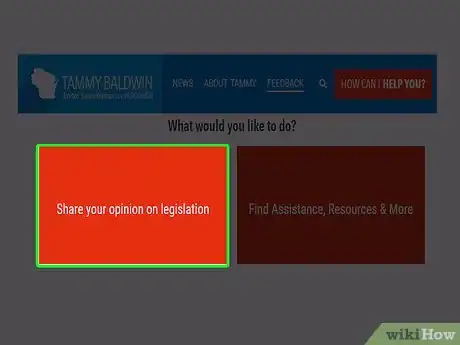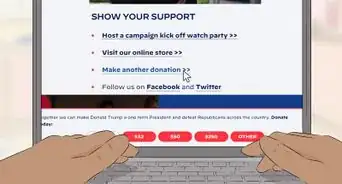X
This article was co-authored by wikiHow Staff. Our trained team of editors and researchers validate articles for accuracy and comprehensiveness. wikiHow's Content Management Team carefully monitors the work from our editorial staff to ensure that each article is backed by trusted research and meets our high quality standards.
This article has been viewed 82,280 times.
Learn more...
Congress is divided into houses: the House of Representatives and the Senate. If you have a question or concern for your representative or senator, you can email them through the official House and Senate websites.
Steps
Method 1
Method 1 of 3:
Emailing a Member of the U.S. House of Representatives
-
1Visit www.house.gov. This is the official website for the US House of Representatives. It lists all of the House members, as well as various committees and legislative activity.[1]
-
2Enter your zip code. Look to the upper right-hand corner of your screen. There will be a map of the United States with the words “Find Your Representative” above it. You’ll see a box with the words “Enter your zip code” above it. Enter your zip code into the box and click “Go.”[2]
- You can also search for representatives by name. Click on “Representatives” in the upper left-hand corner of the www.house.gov screen. Two tabs will show up. One lists representatives by state; the other lists representatives by last name.
Advertisement -
3Enter your street address. On the new screen you should see a list of your state representatives on the left-hand side of your screen. Most states are broken into several congressional districts, each with their own representative. To find your district’s representative look the right hand of the screen for the words “Enter Street Address.” Enter your street address, city, and state in the boxes and click “Find Your Rep By Address.”[3]
- If your district only has one representative, you won’t need to enter your street address. Instead, when you enter your zip code on the main www.house.gov screen, a picture of your representative will show up on the left side of your screen.
-
4Click on your representative’s name. On the new screen you will see your representative’s picture and name on the left-hand side of the screen. The right-hand side of the screen will display a map of your district. Move your cursor over your representative’s name and click.[4]
- At this stage, you can also click on the small letter icon next to your representative’s name. This will take your directly to their contact page.
-
5Click on the “Contact” link. Each representative maintains their own website. As such, there is no uniform place where the “Contact” link will be located. However, each representative will have a “Contact” link prominently displayed somewhere on the homepage of their website. Click on the “Contact” link.[5]
-
6Click on the “Email” link. Once you’ve reached the “Contact” screen, you will find listings of several ways to contact your representative. Each representative’s website will be slightly different. However, you will find an “Email” link prominently displayed somewhere on the “Contract” screen.[6]
- Some representatives have an “Email” box on their websites where you can type and message and click “Send” without having to open your email client.
- Other representatives have an “Email” link that, when clicked, will open your email client. In that case, you will write an email and click “Send” from within your email client.
- Your email be go directly to your representative of their staff.
Advertisement
Method 2
Method 2 of 3:
Emailing a Member of the U.S. Senate
-
1Visit www.sentate.gov. This is the official website of the U.S. senate. It contains a list of senators, as well as legislative histories and other informative links. [7]
-
2Click on the “Senators” button. Look to the upper left-hand corner of your screen. The “Senators” button will be directly below the image of the United States Senate symbol.[8]
-
3Search for your senator. On the new screen you’ll see a box that reads “Choose a State.” Click the box and scroll down to your state.[9]
- You can also search by the senator’s name. Next to the “Choose a State” box you’ll see another box labeled “Choose a Senator.” Click on the box and scroll down to the senator you’d like to contact.
-
4Choose which of your senators you want to email. Each state has two senators. The new screen will display each of your senator’s names. Choose which senator you’d like to email and click on their name.[10]
-
5Click on the “Contact” link. Each senator maintains their own website, so there’s no uniform place where the “Contact” link will be located. Each senator will have a “Contact” link prominently displayed somewhere on the homepage of their website. Click on the “Contact” link.[11]
-
6Click on the “Email” link. Once you’ve reached the “Contact” screen, you will find listings of several ways to contact your senator. Each senator’s website will be slightly different. However, you will find an “Email” link prominently displayed somewhere on the “Contract” screen.[12]
- Some senators have an “Email” box on their websites where you can type and message and click “Send” without having to open your email client.
- Other senators have an “Email” link that, when clicked, will open your email client. In that case, you will write an email and click “Send” from within your email client.
- Your email will go directly to your senator of their staff.
Advertisement
Method 3
Method 3 of 3:
Crafting Your Email
-
1Use the proper salutation. Beginning your email with the proper salutation signals to your representative or senator that you respect their position. This will make them more likely to take your email seriously.[13]
- The proper salutation for a U.S. senator is “Dear Senator ___.” For example, if you were writing an email to Mitch McConnell, you would begin, “Dear Senator McConnell.”
- The proper salutation for a U.S. representative is “Dear Mr. / Mrs. ___.” For example, if you were writing an email to Nancy Pelosi (Name), you would begin, “Dear Mrs. Pelosi."
- For a more formal flourish, address your senator or representative as "The Honorable..." For instance, you might write: "To the Honorable Mrs. Pelosi."
- There is no legal requirement to use a particular salutation. You’re free to call your senator or representative whatever you like. However, your email will probably be taken more seriously if you respect the office of the person you’re writing to.
-
2Write with a professional tone. Your email doesn’t have to be a work of art, but try to keep grammar and spelling mistakes to a minimum. Aim for a friendly yet professional tone, and if you're asking the senator or representative for change, be firm and state your position clearly.
- You may include personal details, but try to keep them relevant to the topic at hand.
-
3State your concern. Representatives and senators get tens of thousands of emails and letters. If your email rambles or talks generally about an issue without getting to the point, it’s unlikely that your representative or senator will hear your voice.
- Start your email by clearing stating the issue you’re writing about. For example, you might say, “I’m writing to expression my opposition to House Bill 1248, which is currently up for debate in the House.”
- Stick to one issue. The more focused your email, the more likely it is to be read and taken into consideration by your representative or senator.
-
4Explain your investment. Say how the topic relates to you. Your senator or representative will be better able to contextualize your concern if you give this information. In some cases, your voice may be amplified by association--if many parents are writing in with concerns about the same change to education policy, for example, this pattern will be noted.
- For instance, if you are a veteran and you are concerned about a proposal to reduce subsidized housing for veterans, say, "As a veteran I am personally acquainted with the social and financial consequences of PTSD."
- Be sure to mention that you are a constituent of this senator or representative.
- If you will be adversely effected--or if you stand to benefit--from a congressional action, mention this and explain the likely ramifications.
-
5Keep it short. Don't write more than a few paragraphs if you want your reader to stay with you. Make sure you say what you need to say. Condense any anecdotes as much as possible.[14]
- Try to keep it under 500 words.
-
6Be polite. You may have good reason to be angry, but you are more likely to be heard if you write a respectful, compassionate email. Refrain from insults, cursing, and threats.
Advertisement
Community Q&A
-
QuestionYour information, while well explained, did not answer my question . I need to know how to email a US Representative when I don't live in their district
 Community AnswerYou can follow the same steps, but instead of indicating your district on the drop-down menu, indicate the district of the Representative you are trying to contact.
Community AnswerYou can follow the same steps, but instead of indicating your district on the drop-down menu, indicate the district of the Representative you are trying to contact. -
QuestionCan I forward an article I received to a representative, senator, or the president?
 DonaganTop AnswererYes, certainly, although there's no guarantee than anyone other than a staff member would see it.
DonaganTop AnswererYes, certainly, although there's no guarantee than anyone other than a staff member would see it.
Advertisement
References
About This Article
Advertisement













































































